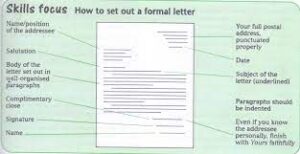A semi-formal letter falls between a formal and an informal letter. In one of my articles, I describe a formal letter as a letter written for official purposes while informal letters are written to friends. But semi-formal letters are letters that are written to people that are totally strange or well known to us. Examples include letters parents send to the school principal, letters written to teachers or family doctors or bosses at work, etc.
In this article we would be looking at Definition and Features of Semi Formal Letter.
You can only identify this type of letter by its features and language used (ordinary speech). The language of this letter is more polite than informal letters.

Features of Semi-Formal Letter
- Writer’s address and date
- Salutation e.g. Dear Dr John, Dear Mrs Olumide.
- Body of the letter
- Conclusion
- Complimentary clause
- Writer’s full name.
Writer’s address: This must appear at the top right-hand side of your letter, followed by the date.
Salutation: It comes immediately after the writer’s address. This is where you use Dear Dr Faith or Dear Mrs Gift.
Body of the letter: This is usually divided into three paragraphs: introduction, main body, and conclusion. The language used is not formal and ordinary speech is acceptable
Main body: This is where the message you want to convey in your letter will be i.e., the main reason for writing the letter.
Complimentary clause. This is where you close the letter. The usual complimentary closing is like ‘Yours sincerely’. The format can be Yours sincerely, followed by your full name. You don’t need to put your signature in semi formal letter.


